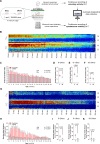Computational and digital analyses in the INSPIRE mouse cohort to define sex-specific functional determinants of biological aging
- PMID: 39671481
- PMCID: PMC11641001
- DOI: 10.1126/sciadv.adt1670
Computational and digital analyses in the INSPIRE mouse cohort to define sex-specific functional determinants of biological aging
Abstract
Biological age, which reflects the physiological state of an individual, offers a better predictive value than chronological age for age-related diseases and mortality. Nonetheless, determining accurate functional features of biological age remains challenging due to the multifactorial nature of aging. Here, we established a unique mouse cohort comprising 1576 male and female outbred SWISS mice subjected or not to high-fat, high-sucrose diet to investigate multiorgan/system biological aging throughout adulthood. Comprehensive functional and biological phenotyping at ages of 6, 12, 18, and 24 months revealed notable sex-specific disparities in longitudinal locomotion patterns and multifunctional aging parameters. Topological data analysis enabled the identification of functionally similar mouse clusters irrespective of chronological age. Moreover, our study pinpointed critical functional markers of biological aging such as muscle function, anxiety characteristics, urinary patterns, reticulocyte maturation, cardiac remodeling and function, and metabolic alterations, underscoring muscle function as an early indicator of biological age in male mice.
Figures






References
-
- Ibanez A., Maito M., Botero-Rodríguez F., Fittipaldi S., Coronel C., Migeot J., Lacroix A., Lawlor B., Duran-Aniotz C., Baez S., Santamaria-Garcia H., Healthy aging meta-analyses and scoping review of risk factors across Latin America reveal large heterogeneity and weak predictive models. Nat. Aging 4, 1153–1165 (2024). - PMC - PubMed
-
- Elliott M. L., Caspi A., Houts R. M., Ambler A., Broadbent J. M., Hancox R. J., Harrington H., Hogan S., Keenan R., Knodt A., Leung J. H., Melzer T. R., Purdy S. C., Ramrakha S., Richmond-Rakerd L. S., Righarts A., Sugden K., Thomson W. M., Thorne P. R., Williams B. S., Wilson G., Hariri A. R., Poulton R., Moffitt T. E., Disparities in the pace of biological aging among midlife adults of the same chronological age have implications for future frailty risk and policy. Nat. Aging 1, 295–308 (2021). - PMC - PubMed
-
- Tian Y. E., Cropley V., Maier A. B., Lautenschlager N. T., Breakspear M., Zalesky A., Heterogeneous aging across multiple organ systems and prediction of chronic disease and mortality. Nat. Med. 29, 1221–1231 (2023). - PubMed
-
- Sayed N., Huang Y., Nguyen K., Krejciova-Rajaniemi Z., Grawe A. P., Gao T., Tibshirani R., Hastie T., Alpert A., Cui L., Kuznetsova T., Rosenberg-Hasson Y., Ostan R., Monti D., Lehallier B., Shen-Orr S. S., Maecker H. T., Dekker C. L., Wyss-Coray T., Franceschi C., Jojic V., Haddad F., Montoya J. G., Wu J. C., Davis M. M., Furman D., An inflammatory aging clock (iAge) based on deep learning tracks multimorbidity, immunosenescence, frailty and cardiovascular aging. Nat. Aging 1, 598–615 (2021). - PMC - PubMed
-
- Farr J. N., Xu M., Weivoda M. M., Monroe D. G., Fraser D. G., Onken J. L., Negley B. A., Sfeir J. G., Ogrodnik M. B., Hachfeld C. M., LeBrasseur N. K., Drake M. T., Pignolo R. J., Pirtskhalava T., Tchkonia T., Oursler M. J., Kirkland J. L., Khosla S., Targeting cellular senescence prevents age-related bone loss in mice. Nat. Med. 23, 1072–1079 (2017). - PMC - PubMed
MeSH terms
LinkOut - more resources
Full Text Sources
Medical

